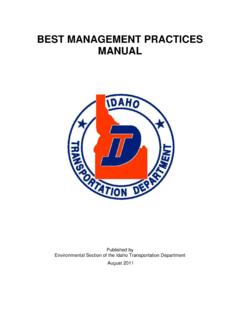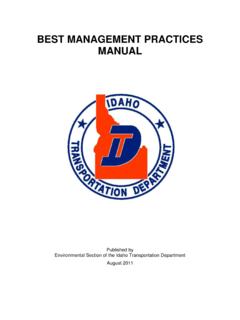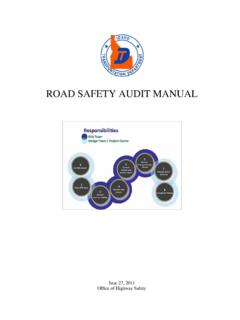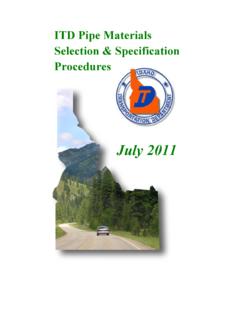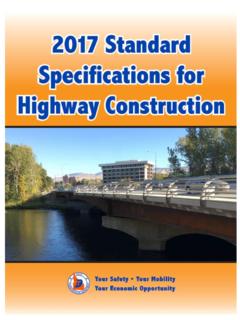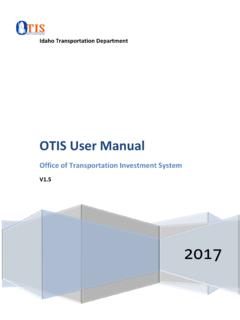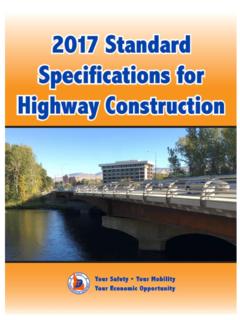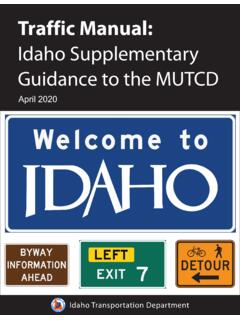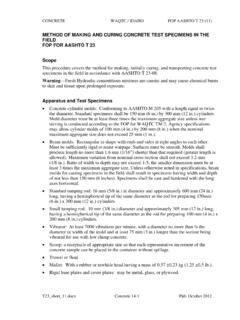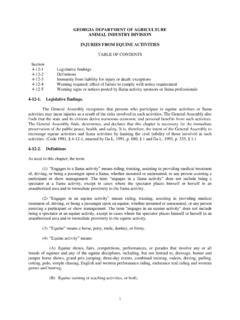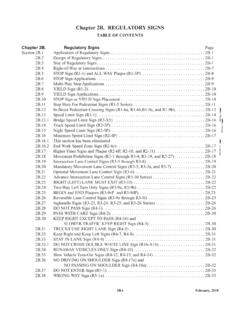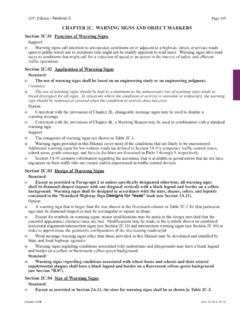Transcription of CHAPTER 3 SIGNS, SIGNALS, AND PAVEMENT MARKINGS
1 CHAPTER 3 SIGNS, SIGNALS, ANDPAVEMENT MARKINGST raffic control devices include traffic signals, signs and pavementmarkings. Traffic control may also be provided by law enforcementofficers, highway personnel or school crossing guards. You must obeydirections given by SignsThere are three types of traffic signs: regulatory, warning, and guide. Youshould learn to recognize them by color and shape as well as the messagesor symbols they carry. Regulatory Signs Regulatory signs are generally black and white,although some are red and white, and must be obeyed at all times. Stop: You must come to a complete stop before entering theintersection ahead.
2 You are required to stop behind the stop lineor a crosswalk if there is one. Yield:Slow down so that you may safely yield the right of wayto other vehicles or pedestrians. Wrong Way: You are approaching a lane of traffic from thewrong way. Do Not Enter: You may not enter this section of roadway fromthe direction you are NOTENTER Speed Limit: The maximum speed limit on this section of road(under ideal driving conditions). Slow Moving Vehicle:You are approaching a slow movingvehicle. You should slow down and approach the vehicle withcaution. This sign has a red perimeter and orange center and isprimarily on off road vehicles (implements of husbandry,construction equipment, etc).
3 No Left Turn No Right turnNo U-Turn Do Not PassProceed Straight Left Turn Only Right Turn Only U-Turn PermittedRailroad Crossing: May also tell you how many tracks you mayexpect a train to appear Signs: Most warning signs are black on yellow. Warning signsalso include the bright yellow school warning signs , and the orange andblack construction zone signs. 3 Way Intersection: You are approaching a 3-way T"intersection and will have to turn either to the right or the must stop and yield to drivers approaching from the othertwo directions. Open Range:You are traveling in an area where livestockhave the right of way and are allowed to roam freely SignalMerging TrafficTwo Way TrafficLane EndsSchool ZoneSchool CrossingPedestrian CrossingDivided Road BeginsDivided Road EndsBridge Clearance Railroad CrossingSlippery When WetKeep Right of IslandHillNo Passing Zone Guide Signs: Guide signs are either white on green for directional anddistance, white on blue for motorists services, or white on brown forcultural, historical, or scenic points of interest.
4 Barricades: Highway departments and construction crews often performwork that requires traffic lands or entire roads to be temporarily orpermanently closed. If a lane or road is closed to traffic, one of threetypes of barricades will be placed in the road as a warning to are either red and white (permanent) or orange and white(temporary). Even though barricades can be different colors, theinstructions they give to drivers are the V-shaped pattern on this barricade means that theroad is closed and traffic can proceed no lines on this barricade angle down to the left,indicating that traffic must pass the barricade on the lines on this barricade angle down to the right,indicating that traffic must pass the barricade on the SignalsTraffic signals are lights that regulate the flow of traffic mainly throughintersections.
5 Most traffic lights have a red light at the top, a yellow light inthe middle, and a green light at the bottom. Red Light:Stop. Come to a complete stop before you reach the stop line,crosswalk, or intersection. Remain stopped until the light changes andcross traffic clears the intersection. Yellow Light:Caution. An amber or yellow light warns that the signal isabout to change to red. If you have not entered the intersection and cancome to a safe stop, you should do so. If you are already in theintersection, you should continue moving and clear it safely. Green Light: Go. You may pass through the intersection in the directionindicated by the signal if the way is clear.
6 Green Arrow:Go. You may proceed if it is safe in the direction thearrow is pointing. Oncoming traffic is required to stop. Red Arrow:Stop. You cannot turn in the direction the arrow is pointing. Flashing Yellow Light:Caution. You should slow down, look carefullyfor hazards and proceed with caution. Flashing Red Light:Stop. You must come to a complete stop, yield tocross traffic or pedestrians, then proceed when the way is clear. Dog House SignalsIdaho highway districts are beginning to use a new type of traffic signal toimprove traffic flow at major intersections. The new signals display fivelights instead of the three standard red, yellow, and green" lights.
7 In mostIdaho counties, the signal will be positioned to the left of a standard three-light signal at intersections, as shown in the above purpose of this type of signal is to allow more vehicles to make left3-4turns at intersections, if it is safe to do so. When you approach this type ofsignal: Red- A single red light means STOP." Yellow- The solid-yellow circular light on the right means the signal ischanging. If you have not entered the intersection and you can come to asafe stop, you should do so. If you are already in the intersection, youshould continue moving and clear it safely.
8 Green- The solid-green circular light on the right means that you mayproceed forward or if you are in the left turn lane you must yield tooncoming traffic before turning left. Green Arrow- The green light on the left with an arrow means that youmay turn left and that oncoming traffic is required to stop, regardless ofwhat other lights are lit. Yellow Arrow- The yellow light on the left with an arrow means thesignal is changing. If you have not entered the intersection and you cancome to a safe stop, you should do so. If you are already in theintersection, you should continue moving and clear it a traffic signal is not functioning, you should always treat theintersection as a 4-way MarkingsThe lines and symbols that are painted on the roadways divide lanes, tellyou where it is not safe to pass other vehicles, where you may not changelanes, which lanes to use for turns, where pedestrians may walk, and whereyou must stop for signs or traffic TURNYIELDON GREEN(GREEN)(GREEN)(YELLOW)(RED)(YELLOW) (GREEN)(YELLOW)(RED) Lane Dividers: This drawing shows three types of lane dividing lines.
9 Adashed yellow line means thatvehicles in either lane can crossthe line if it is safe to do so. Ifthe dashed yellow line ismarked through an intersection,you may pass vehicles in theintersection. Otherwise, nopassing is allowed solid yellow lines mean thatneither lane of traffic can crossthe lines unless they are turning(if it is safe to do so). No passing is allowed. A solid yellow line with a dashed yellow line means that only vehicles inthe lane with the dashed line (lower lane in this drawing) can cross the linesto pass other vehicles. Shared Lanes: Center lanes arereserved for making left turns (orU-turns when they are permitted)from either direction of center lanes are markedon each side by a solid andyellow dashed lines.
10 You maynot travel in the shared turn lanesor interfere with another vehiclepreparing to make a turn from thecenter turn in an IntersectionPassingProhibitedPassingPerm ittedPassingProhibitedNo PavementMarkingsCenter LineOnlyCenter Line andNo-PassingLineShared Center LaneSingle Dashed Yellow LineTwo Solid Yellow LinesSolid and Dashed Yellow LinesRailroad CrossingsRailroad crossings are always dangerous. Driver's should listen and lookboth ways for an approaching train, and for signals indicating anapproaching train. Never proceed until you are certain it is safe to do required to stop, you should do so within 50 feet, but no less than 15feet from the nearest rail of the chance of death or serious injury in a collision between a train and amotor vehicle is 40 times greater than for other highway accidents.
